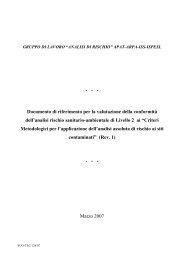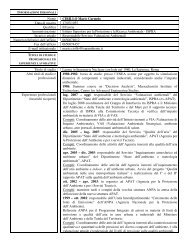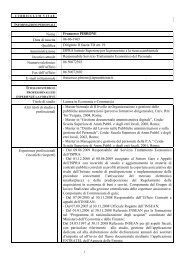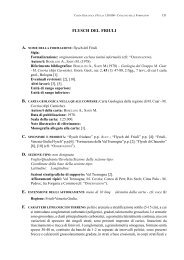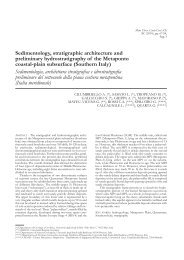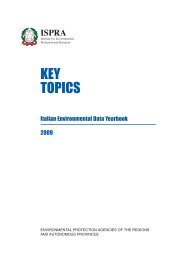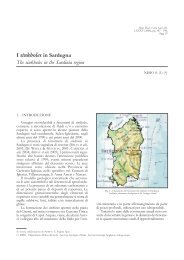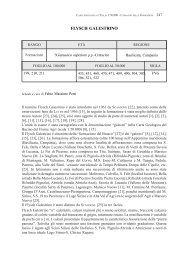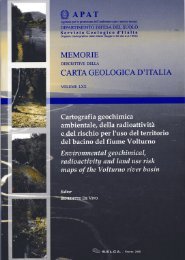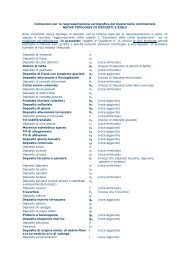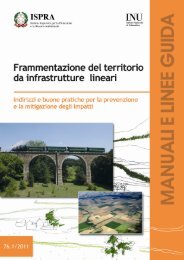Guidebook - Ispra
Guidebook - Ispra
Guidebook - Ispra
You also want an ePaper? Increase the reach of your titles
YUMPU automatically turns print PDFs into web optimized ePapers that Google loves.
Introduction<br />
The fieldtrip “Geological Structure of the Romanian<br />
Carpathians” strives to cross the major tectonic units<br />
of this segment of the Tethyan Chains, with the<br />
purpose of presenting a general approach to the tectonic<br />
and paleogeographic (paleotectonic) problems.<br />
Knowledge of Carpathian geology allows us to understand<br />
the prolongation of the Alps toward the Balkans<br />
and the Dinarides. In order to accomplish the abovementioned<br />
tasks during the fieldtrip, a part of the<br />
significant geological cross sections in the East and<br />
South Carpathians as well as in the Apuseni Mts will<br />
be visited. Thus we will examine the tectonic units issued<br />
from the Tethyan Ocean - squeezed in the Main<br />
Tethyan Suture Zone or obducted on the continental<br />
margins – and their deformed continental margins.<br />
In the areas crossed by the fieldtrip geological maps<br />
and older fieldtrip guidebooks are available. It should<br />
be remembered that in respect to the geological maps<br />
or other guides, in the guidebook proposed here more<br />
or less important differences are possible, determined<br />
by the progress of our knowledge and/or a better understanding<br />
of the geological processes.<br />
Geological Map of Romania, scale 1: 200,000, sheets:<br />
Rădăuti, Topliţa, Piatra Neamţ, Odorhei, Brașov,<br />
Turda, Brad, Deva, Tg. Jiu, Baia de Aramă, Reșiţa.<br />
Geological Map of Romania, scale 1: 50,000, sheets:<br />
Vatra Dornei, Pojorâta, Câmpulung Moldovenesc,<br />
Dămuc, Voșlăbeni, Miercurea Ciuc, Brașov, Zărnești,<br />
Codlea, Zlatna, Câmpeni, Avram Iancu, Biharia, Brad,<br />
Deva, Lupeni, Schela, Tismana, Obârșia Cloșani,<br />
Orșova, Reșiţa, Bocșa.<br />
The Structure of the East Carpathians (Moldavia-<br />
Maramureș Area) by M. Săndulescu et al., 1981,<br />
Guide to Excursion B1.<br />
Structural Relations between Flysch and Molasse<br />
(The East Carpathians Model) by M.Săndulescu et<br />
al., 1981, Guide to Excursion A5.<br />
The Structure of the Apuseni Mountains by M.Bleahu<br />
et al., 1981, Guide to Excursion B3.<br />
Metamorphosed Paleozoic in the South Carpathians<br />
and Its Relations with the Pre-Paleozoic Basement by<br />
H.Kräutner et al., 1981, Guide to Excursion A1.<br />
The Structure of the South Carpathians (Mehedinţi-<br />
Banat Area) by S.Năstăseanu et al., 1981, Guide to<br />
Excursion B2.<br />
Excursion to South Carpathians, Apuseni Mountains<br />
and Transylvanian Basin. Description of stops by<br />
Berza et al., 1994 ALCAPA II.<br />
GEOLOGICAL STRUCTURE OF THE ROMANIAN CARPATHIANS<br />
Leader: M. Sandulescu<br />
Associate Leader: R. Dimitrescu<br />
Geology of the South Carpathians in the Danube<br />
Gorges (Romanian Bank) by Pop et al., 1997.<br />
General Geological Setting<br />
General Structure and Evolution of the Romanian<br />
Carpathians<br />
(according to Săndulescu, 1980, 1984, 1994)<br />
The Carpathians are a segment of the Tethyan<br />
Chains; toward west they join the Alps and toward<br />
south and south-east the Balkans and the Rhodope.<br />
The Carpathian Foreland includes several platforms<br />
(Scythian, Moesian) or cratons (East European) as<br />
well as the Cimmerian North Dobrogea Orogen<br />
(Figure1). The Carpathian Folded Area is the result<br />
of several tectogenetic events of different ages: Cretaceous<br />
(generating the Inner Zones named Dacides)<br />
and Miocene (the Outer Zones named Moldavides).<br />
Upper Cretaceous and/or Paleogene post-tectogenetic<br />
covers develop above the Inner Zones. The Pannonian<br />
and the Transylvanian, Neogene molassic depressions<br />
overlie important parts of the Inner Zones and a part<br />
of their post-tectogenetic covers. A Neosarmatian-Eopleistocene<br />
molassic asymmetric foredeep develops<br />
in front of the Orogen, partly (inner limb) superposed<br />
on its external zones (Figure 1). The Folded Area can<br />
be divided into several major tectonic ensembles:<br />
The Main Tethyan Suture Zone (MTS) which<br />
groups together tectonic units constituted by Middle<br />
Triassic-Middle Jurassic ophiolitic complexes overlapped<br />
by sedimentary formations whose age (Middle<br />
and Upper Triassic, Jurassic or Upper Jurassic-Lower<br />
Cretaceous) is different from the age of the ophiolites<br />
they cover. The MTS which runs along the Vardar<br />
Zone (between the European and the Apulian continental<br />
margins) splits – from Beograd toward north<br />
or north-west - into two branches: the South Pannonian<br />
(separating the Apulian microplate from the<br />
Fore-Apulian one) and the Transylvanidian-Pienidian<br />
(situated between the European and the Fore-Apulian<br />
margins) (Figure2).<br />
The Fore-Apulian Microcontinent (FAM) is situated<br />
on the opposite side with respect to the European<br />
margin, considering the MTS a major geotectonic axis<br />
of symmetry of the Tethyan Chains. The FAM groups<br />
together the Austroalpine, the Central West Carpathians<br />
and the North Apusenide units (Figure 1), as well<br />
as the units covered by the Pannonian Depression<br />
B12<br />
3 - B12<br />
Volume n° 1 - from PR01 to B15



